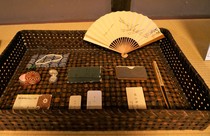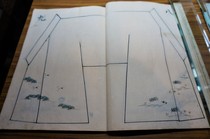Special Exhibition Kimono no Mushiboshi (「着物の虫干し展」) was held at the Nagae Family Residence, a Tangible Cultural Property designated by Kyoto City
The Art Research Center (ARC) co-organized the special exhibition Kimono no Mushiboshi (「着物の虫干し展」) at the Nagae Family Residence, a tangible cultural property designated by Kyoto City, on March 20 and 21, 2021.
Due to COVID-19, this was the first time since the byobu matsuri (folding screen festival) in summer 2019 that the residence was open again to the public, and it welcomed a total of 50 visitors.
About the Event
The Nagae family were merchants of the kimono fabric, and their family residence served as both a working and living space for many generations.
During this exhibition at the residence, kimonos from the family collection were taken from the storehouse and air-dried--a traditional Japanese practice called mushiboshi--to prevent the clothes from insects and mold.

These kimonos were worn by the seventh generation of the Nagae family during the early Shōwa period. The head of the seventh generation was very fond of the Gion Festival, participating in the festival's preservation society and as a musician for the Gion bayashi (orchestral music accompanying the festival). He wore the summer haori on display to attend various events of the Gion Festival.
Furthermore, tools, goods, and trading documents were exhibited, providing a glimpse into the daily life and business of a merchant family in the rakuchu (in the capital) of that time.

The items from the family collection displayed at this event were made available to the public for the first time after they had remained in the storehouse for a long time.
In a separate room, visitors could learn about the ARC's research outcomes in digital-archiving the Nagae family collection.
About the Nagae Family Residence
Designated as a tangible cultural property by the City of Kyoto, the Nagae Family Residence was built between the late Edo period and the Taishō period and is located in the center of Kyoto.
The main building is a two-story traditional wooden townhouse--also referred to as kyo-machiya--which consists of a north wing constructed in 1868 (closed to the public) and a south wing constructed in 1905.
Although some parts of the building have been restored in recent years, most parts of the residence, including the glass windows, remain the same as built more than a century ago.
With the office space at the front and private rooms at the back, including one for ceremonial occasions, each room had a clearly defined function.
Furthermore, a family business trademark is found throughout the residence that differs from the kamon (family crest) printed on their kimonos for the Gion Festival.
About the ARC's Research
The ARC has been involved in the research on the Nagae Family Residence for many years. After receiving a donation of their collection, including hanging scrolls, folding screens, kimonos, and daily life tools, we have been researching and digital-archiving those items.
In recent years, some kimonos and design pattern books have been discovered in the storehouse, revealing new aspects of the Nagae family's business as kimono fabric merchants. We also introduced these new findings at this exhibition.
In the future, the ARC strives to continue to research and digital-archive the remaining items in the storehouse to enrich the Nagae family collection database and preserve Japanese cultural heritage.
Nagae Family Residence Links: Official Website Facebook Page Instagram
___________________
Organizer: Hoosiers Corporation
Co-organizer: Art Research Center, Ritsumeikan University








